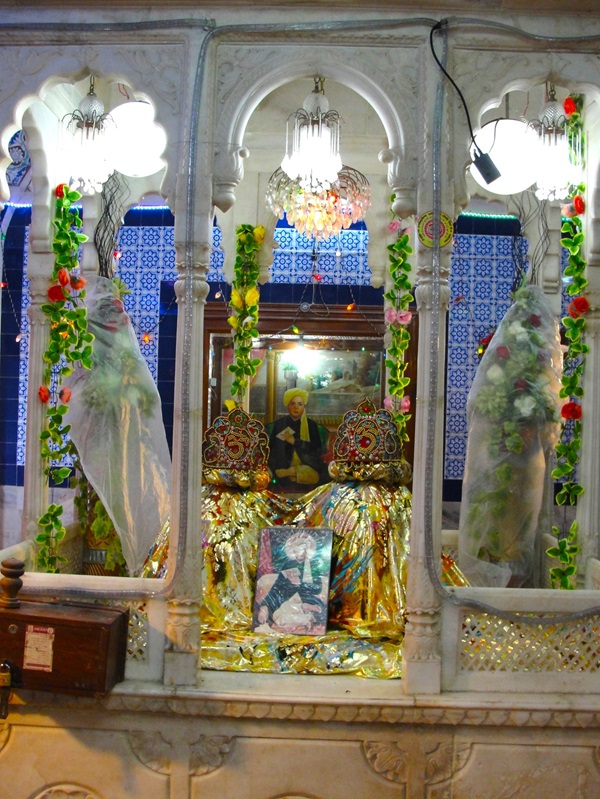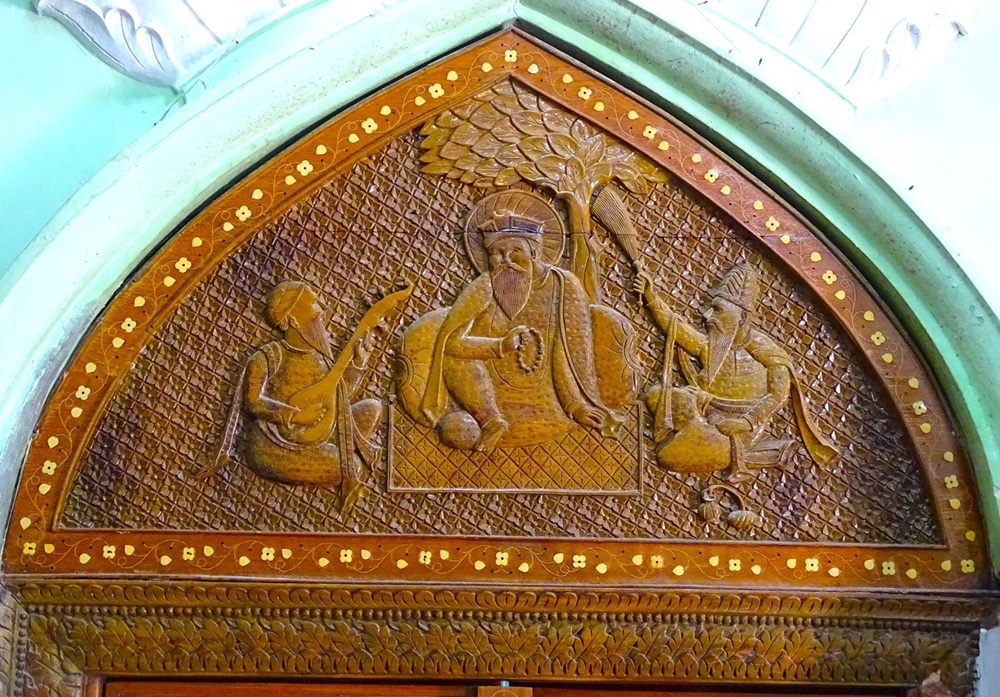Written by: Zulfiqar Ali Kalhoro
Posted on: July 10, 2024 |  | 中文
| 中文
The western view of Swami Shankaranand Bharti Temple complex (Picture credits to Zulfiqar Ali Kalhoro)
The Swami Shankaranand Bharti temple is a unique and profoundly significant place for Hindus in Shikarpur. Its location near Sindh Wah, its stunning woodwork, marble carvings and paintings make it an outstanding monument for the many Hindus in Shikarpur. The temple complex of Shankaranand Bharti is not just another religious site but a unique cultural and religious gem in the city of Shikarpur.
Shikarpur was once home to many Hindu ascetics, including Naths Jogis, whose Samadhis and Marhis were located in different localities of Shikarpur. On the renunciatory orders in Hinduism, Govind Sadashiv (G.S) Ghurye (1953), in his book Indian Sadhus, writes that there are ten orders of ascetics (popularly known as Dasnamis), namely Aryana, Asrama, Bharti, Giri, Parvata, Puri, Sarasvati, Sagara, Tirtha and Vana. Moreover, he believes that each renouncer adds his adopted name to one of these ten orders depending on the center where he was initiated, or the teacher who initiated him. On the other hand, Bansi Dhar Tripathi (1978) writes in his book The Sadhus of India: The Sociological View, that there are more than sixty-five sects of world renouncers.
In Sindh, there are four main groups of ascetics whose shrines dominate the landscapes of the towns and villages. They include Nath, Giri (also variously pronounced Gur, Gar and Gir in Sindhi), Puri and Bharti. Swami Shankaranand Bharti belonged to the Bharti renunciatory order. The temples and Samadhis of Naths and Girs are located in the towns in upper Sindh, but one does not find any noted temple or samadhi of Puri and Bharti ascetics in upper Sindh. Shikarpur was the only town in upper Sindh where the temple of Bharti ascetics is found. Swami Shankaranand Bharti was believed to have founded this temple. Initially, there were samadhis of Swami Shankaranand Bharti and his guru, and later, he played a significant role in expanding it to include other secular and religious buildings. According to Sindh Ja Sant by Dr. Dayal ‘Asha’, Swami Shankaranand Bharti was born in Sindh’s Matiari town. His parents named him Narain. He received a religious education from Gosain Shivaram Bharti, who was his father's guru. It is believed that Narain's father had promised his guru Shivaram Bharti that he would hand over his son to him for teaching him the basics of the Hindu religion. Shivaram Bharti initiated Narain into the Bharti ascetic order, and he was given the new name of Shankaranand Bharti. He also learnt Sanskrit and Hindi and received religious education from Guru Gobind Gir, another eminent Hindu ascetic who belonged to the Gir ascetic order of Hinduism.
However, Lokram Dodeja (1993) presents another narrative about Swami Shankaranand Bharti’s initiation. According to him, Swami Adhbhanand Bharti used to look after his guru’s ashram in Ghazni, Afghanistan. He also used to visit Shikarpur annually. Lokram Dodeja believes that Swami Shankaranand Bharti was initiated into the Bharti ascetic order by Swami Adhbhanand Bharti. Moreover, Lokram Dodeja (1993) states that Swami Shankaranand Bharti’s birth name was Naraindas. It was Swami Adhbhanand Bharti who gave him a new name, Shankaranand Bharti. When Swami Adhbhanand Bharti died in Ghazni, Afghanistan, Swami Shankaranad Bharti travelled to Ghazni to bring back the mortal remains of his guru to Shikarpur, where he built the Samadhi of his spiritual master. An impressive domed structure was constructed on the Samadhi. It was during his time that the ashram expanded, mainly due to Swami Shankaranand Bharti's efforts. When Swami Shankaranand Bharti died in 1885, he was also laid to rest next to his guru, Swami Adhbhanand Bharti.

Samadhis of Swami Shankaranand Bharti and Swami Adhbhanand Bharti (Picture credits to Zulfiqar Ali Kalhoro)
Today, the Swami Shankaranand Bharti ashram or temple has a syncretic look, a testament to its inclusive nature. There, one finds posters and images of Hindu deities, temple Gaddisars, Sikh Gurus, and Udasi saints. This temple showcases typical Sindhi architecture, featuring domes and distinctive decorations. Pictures of Hindu deities, including Shiva, Ram, Hanuman and Durga, are displayed in the Swami Shankaranand Bharti temple. There are also posters of Hindu saints, such as Satguru Sain Satramdas, and Udasi saints, including Baba Har Bhajan Udasi, Baba Roop Bhajan Udasi, Baba Kishan Bhajan Udasi, Baba Gobind Bhajan Udasi, Baba Shiv Bhajan of Pooj Udasin Samadha Ashram in Shikarpur, Baba Gharib Das of Ghouspur, Baba Kalyan Das of Chhatar Darbar in Balochistan, and others.
Before entering the temple complex, one is greeted by the old remains of the gate adorned with paintings. Upon crossing the gateway, one steps into the temple complex. To the left, a building houses the temple management office, Bhandaro, and the kitchen. Directly opposite, another building provides accommodation for women pilgrims and a space for performing rituals. Passing through carved wooden doors, one goes to the darbar sahib, where the Singhasan (throne) and Samadhis of Swami Shankaranand Bharti, his guru, and Gaddisars are located. In front of the Darbar Sahib building is the Shivalo, with a Shiva linga placed in the garbhagriha (innermost sanctuary). Behind the Shivalo is Lal Sain Jo Ghat, and the names of donors are inscribed on the floor, before the entrance to the Darbar Sahib building.
As one enters the Darbar Sahib building, the Singhasan (throne) immediately catches one’s eye. The marble Singhasan depicts Guru Nanak with his companions Bhai Bala and Bhai Mardana, and images of other Sikh gurus. A large picture on top of the Singahsan also represents Guru Nanak with Bhai Bala and Bhai Mardana. On the Parikrama (circumambulation) pathway, subsidiary shrines are also located. Akhand Jyot of Jhulelal is also found along the Parikrama pathway. Just opposite this, Akhand Jyot of Jhulelal is located a samadhi, probably of Gaddisar of Swami Shankaranand Bharti temple. To the right of Singhasan is a wooden door that opens to the Samadhis of Swami Shankaranand Bharti and his guru, Swami Adhbhanand Bharti. A wooden door is noted for carved images of Guru Nanak with Bhai Bala and Bhai Mardana, with inlaid work that is rare in the temples and darbars of Sindh. However, such refined inlaid wooden doors in Masand Darbar in Shikarpur can be seen. I want to emphasize that Shikarpur's craftsmanship is distinct and elegant. Among the wooden doors displayed in a museum or for sale in the market, the decorative style of Shikarpur doors stands out. Shikarpur's carved wooden doors are unmatched in all of Sindh. This wooden door of Samadhi of Swami Shankaranand Bharti is matchless for its magnificent decoration. A marble chhat or chhatri (pavilion) is constructed over the samadhis of both Swami Shankaranand Bharti and Swami Adhbhanand Bharti. The interior of the tomb of Swami Shankaranand Bharti is adorned with paintings representing mainly floral patterns and scrolls, a decoration scheme commonly found in Muslin tombs in Sindh. It seems that the tomb and paintings were made by Shikarpuri artisans and masons. It is also likely that artisans from Punjab were also employed to engrave a few doors in the Swami Shankaranand Bharti temple.

Carved images of Guru Nanak with Bhai Bala and Bhai Mardana (Picture credits to Zulfiqar Ali Kalhoro)
The wooden thrones (takhts) where Swami Shankaranand Bharti's Gaddisars (custodians) used to sit are exquisitely carved. The most noticeable is one that was used by Swami Shankaranand Bharti himself, which is placed in the temple.
Apart from the Samadhis of Swami Shankaranand Bharti and Swami Adhbhanand Bharti, there are also Samadhis of Gadhisars of the temple, which are located north of Swami Shankaranand Bharti’s samadhi. The most prominent Gaddisars whose Samadhis are situated in the temple belong to Swami Gautmanand Bharti, Swami Sahajanand Bharti, Swami Dayanand Bharti, Swami Parmanand Bharti, Swami Ramanand and others. It is said that after the death of Swami Shankaranad Bharti, Swami Gautmanand became the Gaddisar of the temple. The last Gaddisar of the temple was Swami Kesvanand Bharti, who left for India after the Partition of 1947. Today, the Swami Shankaranad Bharti temple is managed by the trust.
The impressive tomb of Swami Shankaranand Bharti showcases the exquisite Panjratna style, an architectural marvel that never fails to captivate the observer. This unique Samadhi architecture is a rarity in the Sindh Province, adding to its historical and cultural significance. When viewed from the western side, the domes of the Swami Shankaranand Bharti temple complex create a striking visual illusion, as if rising from a mirage, adding to the site's allure.
The writer Is an anthropologist. He has authored 15 books on Pakistan’s cultural heritage and anthropology. He tweets @kalhorozulfiqar
You may also like: